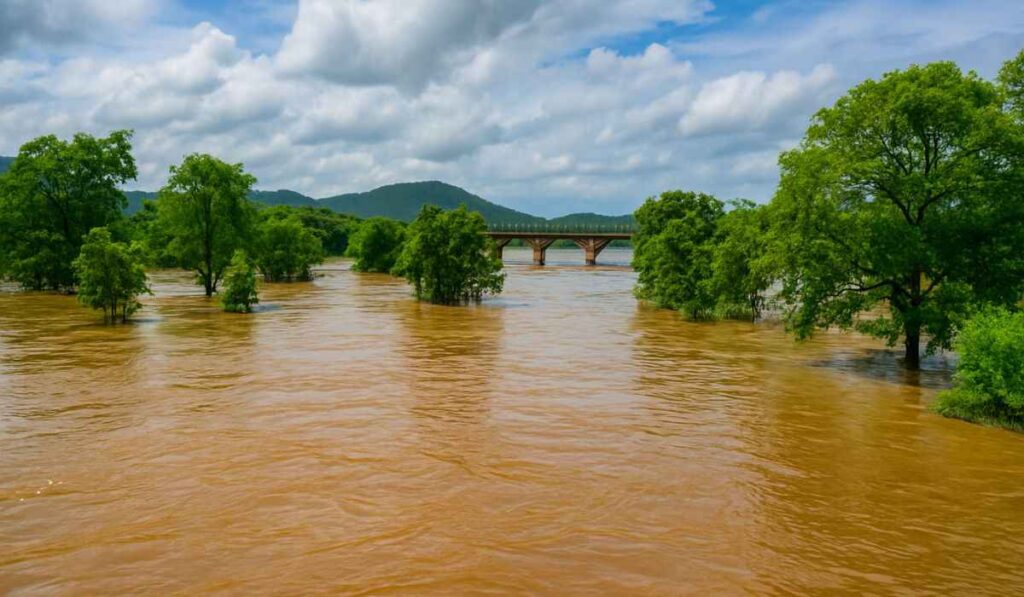The 2025 monsoon has thrust the flood situation near Krishna river into national headlines. Relentless rainfall, surging dam releases, and rising fears have created a cascading disaster across Karnataka’s heartland, submerging entire villages, crippling transport, and threatening the livelihoods of countless families.

What Triggered This Crisis?
For weeks, heavy rainfall in Karnataka and neighbouring Maharashtra has drenched the Krishna river basin. The situation escalated as torrential downpours forced authorities to release unprecedented volumes of water from reservoirs like the Basava Sagara (Narayanpur Dam).
Key Triggers:
- Incessant rains: The Western Ghats region, a catchment area, experienced extraordinary precipitation, swelling river systems beyond safe limits.
- Dam releases: To prevent dam breach, all 30 gates of Basava Sagara were opened. Simultaneously, other major reservoirs, including Almatti and Tungabhadra, rapidly filled, demanding similar emergency action.
- Maharashtra inflows: Additional heavy inflows from Maharashtra raised Krishna’s volume even further, setting off cascading alerts downstream.
- Tributary threat: The Bhima and Malaprabha rivers—Krishna’s vital tributaries—also neared danger marks, worsening the flood situation near Krishna river.
Read Also : Mumbai Under Extreme Rainfall Alert: How 2025’s Monsoon Is Putting the City to the Test
Real-World Impact: Village Isolation and Urban Anxiety
The flood situation near Krishna river has led to concrete disasters on the ground.
- Submerged bridges: Key road links like Sheelhalli-Hanchinal were swallowed by floodwaters, cutting off villages (Kaddaragaddi, Yarigodi, Hanchinal) from essential services. Residents now trek detours of 45km or more.
- Evacuations rise: Rapid inundation has forced authorities to move rural populations to rehabilitation centres across affected districts.
- Crop damage: Over 1.2 lakh hectares of crops, especially pulses such as toor dal, black gram, and soybeans, have been destroyed—raising specters of food insecurity and economic hardship.
- Emotional toll: Besides material costs, families face uncertainty, loss of homes, and psychological strain as the flood situation near Krishna river unfolds.
Read Also: Mithi River: Inside Mumbai’s Battle Against Rain!
By the Numbers: A Flood Measured in Millions
- Over 4.5 lakh cusecs of water discharged from the Prakasam Barrage.
- All 30 gates of Narayanpur Dam opened simultaneously; similar action at Gurusanagi Barrage.
- 319 TMC of floodwater released into the Bay of Bengal so far.
- Reservoirs at full capacity: Almatti (123.08 TMC), Tungabhadra (76.91 TMC), Narayanapura (33.31 TMC).
- Village cutoff: More than a dozen communities made inaccessible, requiring air or boat operations in extreme cases.
Emergency Response: The Human Factor
The flood situation near Krishna river prompted Karnataka’s administration and relief forces into hyperactivity:
- IMD rainfall alert: Constant weather updates, with yellow and orange alerts for further heavy rain.
- Relief centres: Immediate setup in risky areas, providing food, shelter, and basic medical aid.
- Water resource management: Crest gates dynamically operated to minimize downstream devastation, although rural inundation proved harder to control.
- Volunteer efforts: Locals, police, and NDRF teams worked together, rescuing stranded families and livestock.
Challenges for Recovery
- Receding floodwaters: With continued rainfall, there’s little time for natural drainage—waterlogged soils hamper cleanup.
- Agricultural loss: The economic blow from crop destruction will reverberate for months, as farmers struggle to replant and rebuild.
- Health and sanitation: Stagnant water and impassable roads threaten outbreaks of waterborne diseases and delay delivery of essentials.
- Infrastructure repairs: Scores of rural roads, bridges, and power lines are damaged, requiring rapid yet enduring solutions.
How Are People Coping?
- Adaptive routes: Villagers forced to walk hours for supplies, or wait for temporary bridges and raft crossings.
- Digital alerts: With phone alerts and social media, communities receive real-time updates on the flood situation near Krishna river and instructions for evacuation.
- Solidarity: Community kitchens and shelters showcase the resilience and neighborliness of affected families as they weather the monsoon’s assault.
Looking Forward: Will the Flood Situation Ease?
Forecasts from the IMD suggest that heavy rainfall is likely to continue for at least another week in vast parts of Karnataka, with the Krishna basin expected to remain in spate. Reservoir releases will be closely monitored, and rural relief efforts will intensify as long as yellow and orange alerts persist.
Authorities recommend:
- Staying alert to weather and evacuation advisories.
- Conserving potable water and avoiding travel near riverbanks.
- Supporting relief operations with volunteer and community support.
- Farmers are urged to contact agriculture and revenue departments for crop loss aid immediately.
Conclusion
The flood situation near Krishna river has exposed vulnerabilities in infrastructure, disaster management, and rural livelihoods. Yet, amid crisis and loss, it reveals the inspiring resolve of Karnataka’s communities and the profound power of nature. The coming weeks will test both the administration’s response and the public’s ability to adapt as the rain-drenched monsoon season continues.

